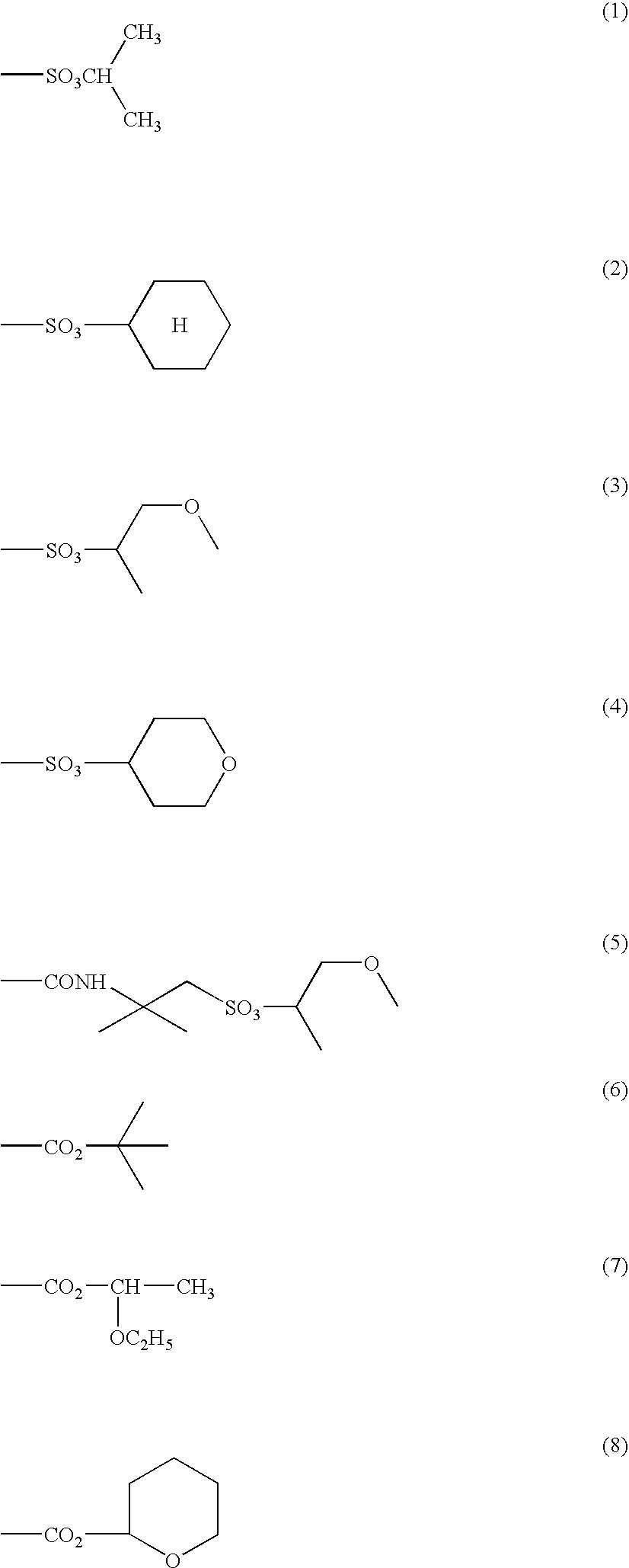Metal Pattern Forming Methd, Metal Pattern Obtained by the Same, Printed Wiring Board, Conductive Film Forming Method, and Conductive Film Obtained by the Same
a technology of metal pattern and conductive film, which is applied in the direction of metallic pattern materials, resistive material coatings, metallic material coating processes, etc., can solve the problems of high frequency characteristics deterioration, expensive apparatus such as a -ray generating apparatus and an electron beam generating apparatus, and achieve the effect of increasing the adhesion of metal layers according to the invention, eliminating incidences of exfoliation, and easy generation
- Summary
- Abstract
- Description
- Claims
- Application Information
AI Technical Summary
Benefits of technology
Problems solved by technology
Method used
Image
Examples
embodiment (
3)
[0254] Embodiment (3) include a step (I-3-1) of forming on a base material a photosensitive layer containing a light to heat conversion substance and a binder, and forming a polymer layer by chemically bonding a polymer having a functional group that interacts with an electroless plating catalyst or a precursor thereof directly onto the entire surface of the photosensitive layer, and a step (I-3-2) of forming, in the pattern form, a polymer layer that interacts with the electroless plating catalyst or precursor thereof by irradiating the polymer layer with radiation in the pattern form and ablating the photosensitive layer.
[0255] Hereinafter, the steps in embodiment (3), (I-3-1) and (I-3-2), are described respectively.
[0256] The step (I-3-1) in embodiment (3) step is first described.
[0257] Step (I-3-1) in embodiment (3) is a step of forming on a base material a photosensitive layer containing a light to heat conversion substance and a binder (hereinafter, the photosensitive lay...
example 1
(Preparation of Substrate)
[0369] The following composition was applied onto the surface of a base material, polyimide film (product name: Kapton, manufactured by Du Pont-Toray) by using a coating bar of rod No. 10 and dried at 100° C. for 1 minute, to give an intermediate layer having a thickness 1.6 μm and containing an infrared absorbent, which was used as substrate A in Example 1.
[0370] The Rz of the base material, polyimide film, as determined by measuring the surface in the range of 40 μm×40 μm according to the method specified in JIS B 0601 and by using Nanopics 1000 (manufactured by Seiko Instruments Inc.) was 15 nm. When the surface of substrate A having an intermediate layer formed on the polyimide film was also measured in a similar manner, the Rz was 10 nm, indicating that the surface roughness of substrate A used in Example was within the preferable range of the invention.
[0371]
Epoxy resin (Epikote, Yuka-shell Co, Ltd.)2 gInfrared absorbent (IR125, manufactured by0.2...
example 2
(Preparation of Substrate)
[0378] The following intermediate layer coating solution (photopolymerization composition) was applied onto the surface of a base material, the polyimide film used in Example 1, by using a rod bar of No. 18, dried at 80° C. for 2 minutes, to give an intermediate layer having a film thickness of 6 μm.
[0379] Then, the base material having the intermediate layer above was exposed to light by using a 400 W high-pressure mercury lamp (Type: UVL-400P, manufactured by Riko Kagaku Sangyo) for 10 minutes allowing partial hardening, to give substrate B used in Example 2.
[0380] The Rz of substrate B, as determined in a similar manner to the polyimide film base material, was 12 nm, indicating that the surface roughness of substrate B used in the Example was within the preferable range of the invention.
[0381]
Allyl methacrylate / methacrylic acid copolymer (copolymerization 2 gmolar ratio: 80 / 20, average molecular weight: 100,000)Ethylene oxide-modified bisphenol A d...
PUM
| Property | Measurement | Unit |
|---|---|---|
| surface roughness | aaaaa | aaaaa |
| surface roughness | aaaaa | aaaaa |
| dielectric constant | aaaaa | aaaaa |
Abstract
Description
Claims
Application Information
 Login to View More
Login to View More - R&D
- Intellectual Property
- Life Sciences
- Materials
- Tech Scout
- Unparalleled Data Quality
- Higher Quality Content
- 60% Fewer Hallucinations
Browse by: Latest US Patents, China's latest patents, Technical Efficacy Thesaurus, Application Domain, Technology Topic, Popular Technical Reports.
© 2025 PatSnap. All rights reserved.Legal|Privacy policy|Modern Slavery Act Transparency Statement|Sitemap|About US| Contact US: help@patsnap.com



